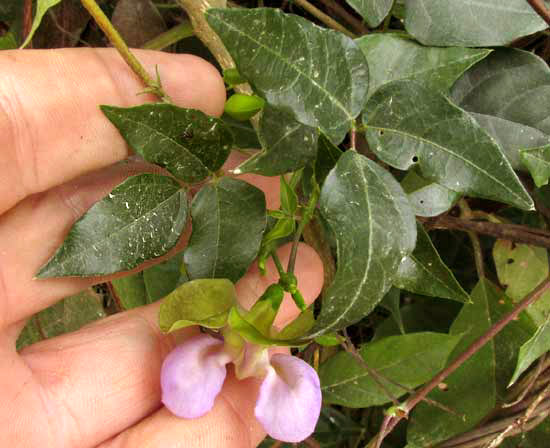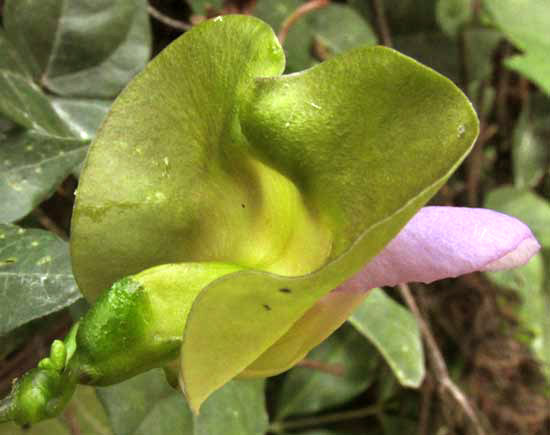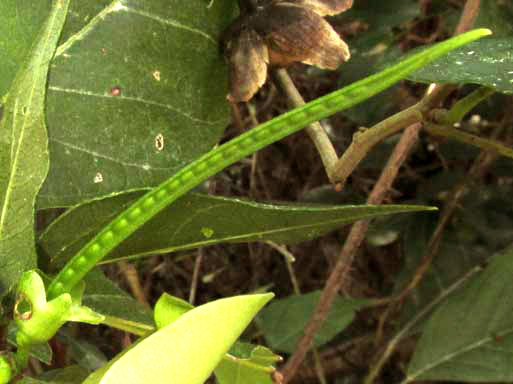Excerpts from Jim Conrad's
Naturalist Newsletter
from the March 20, 2016 Newsletter issued from Hacienda Chichen Resort beside Chichén Itzá Ruins; limestone bedrock; elevation ~39m (~128ft), N20.675°, W88.569°; central Yucatán state, MÉXICO
"ELEGANT BEAN"
A few kilometers east of Hacienda Chichen a narrow gravel road cut through a low rise exposing low limestone walls. Weeds, bushes and vines formed such a dense tangle over the exposed limestone that it was impossible to make out any plant's general shape; all you could see were small parts of any one plant. Still, a pinkish-violet blossom caught my eye, where a vine with trifoliate (three-parted) leaves sought a spot in the sun. Below, you can see the vine's pink flower and trifoliate leaves:

Already in that picture it's clear that the flower is doing something strange. A close-up shot from the blossom's front is shown below:

Wildflower fanciers and gardeners might recognize this as a papilionaceous flower typical of the huge Bean Family, meaning that the two colored side-petals are "wings," and the pale, curving structure in the center is the "keel" composed of two lower petals fused along their common margins, forming something like a boat's keel. However, what's that green, two-lobed object rising behind the petals? At first I thought it was an expanded calyx, but then I looked behind the blossom and saw what's shown below:

The small, dark-green calyx from which the petals arise is clearly discernible at the picture's lower, left, and none of its sepals are expanded, so that means that the green, flaring item has to be the bean flower's topmost petal, the "standard," or "banner." Another view of the calyx, again at the lower, left, is shown below in a picture of an immature, legume emerging from a calyx with five different-sized sepals:

Whenever I see a vine with trifoliate leaves and bean-type flowers with the keel curved in this manner I think of the genus Vigna, a genus famous for providing such important food species as the Adzuki Bean (Vigna angularis), the Cowpea (Vigna unguiculata), and the Mung Bean (Vigna radiata). This time last year we found a wild Vigna species, Vigna candida, at Río Lagartos. You might enjoy comparing our present Vigna with that one at www.backyardnature.net/mexnat/vigna.htm
This week's new Vigna species is one usually listed as VIGNA ELEGANS*, found in the Yucatan Peninsula and south through Belize and Guatemala to El Salvador, and in the Caribbean. It bears no Spanish or English names, though the Maya call it Juul iim. In Latin the species name elegans refers to the flower's elegance, so here we'll name it the Elegant Bean.
As so often is the case when gene sequencing is done on large traditional genera like Vigna, nowadays the wonderful old genus Vigna has been split up, "real" Vignas species mostly seen as Old World species. Now they have burdened our elegantly named with the eminently unpronounceable Sigmoidotropis elegans.
So, that's the way it goes with comfortable old concepts.